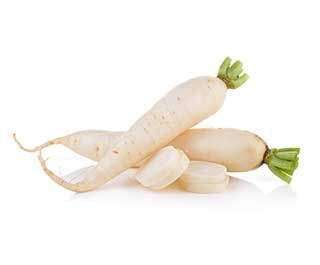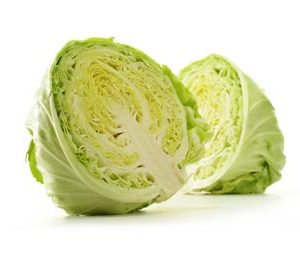An old Chinese proverb states, “Eating pungent radish and drinking hot tea lets the starved doctors beg on their knees.” There’s probably some truth to this saying, as radishes are among the most nutritionally loaded low-calorie vegetables you can enjoy today.
Most radishes in the U.S. are known for their red skin and round shape, but have you ever tried the long and white Asian variety called daikon? Discover the various benefits and culinary uses of daikon, and why it’s worthwhile to add to your diet.
What Is Daikon?
You may know it as an Oriental radish, but daikon (Raphanus sativus var. longipinnatus) actually goes by many names, including mooli, Satsuma radish, Chinese radish and most notably, Japanese radish. In fact, daikon is Japanese for “big root.”
Daikon is believed to have originated in the Mediterranean regions and eventually spread to Asian countries like Japan, China and Korea, where it is utilized in various dishes. It is easily distinguished from other radishes by its large, vibrant green leaves and a long white root, resembling a pale carrot. Daikon can grow up to 18 inches long, and weigh 1 to 4 pounds.
Daikon’s flavor is considered milder and less peppery than other radishes. Served raw, it is subtle and tangy with a crisp and juicy texture. When cooked, it tastes similar to cooked turnips.
Although the root is the most utilized part of daikon, it is technically a cruciferous vegetable. In Asian countries, the root is commonly pickled and eaten as a side dish, or grated, cubed, or thinly sliced for addition to main dishes. Nevertheless, the leaves should not be thrown away, as they offer their own plethora of health benefits.
You can enjoy daikon sprouts (called “kaiware” by the Japanese), which have a pungent and peppery flavor that adds a kick to sandwiches and salads. They are best consumed raw or used as garnish.
5 Daikon Health Benefits
You can’t go wrong with adding daikon to your favorite meals, as it offers a multitude of nutrients that can be advantageous to your health.
Daikon is known to help boost a weak digestive system. A 2017 study also learned that isothiocyanates, which give daikon its peppery and pungent qualities, were found to help reduce the risk of breast cancer.
Daikon also contains considerable amounts of potassium, vitamin C and phosphorus — nutrients essential for good health.
While you may think that daikon’s benefits are only available through the root, you’ll be surprised to learn that its leaves have impressive nutritional value, too. They’re actually loaded with vitamin A, which is essential for eye health, and vitamin C, iron and calcium.
Daikon may help optimize your well-being by:
- Boosting digestive health — Daikon may help facilitate better digestion of proteins and fats,which in turn helps inhibit constipation. Its antioxidants were also found to help trigger bile flow, which is essential in breaking down and absorbing fats.
- Assisting in detoxification — As a diuretic, daikon may help stimulate urination, which is necessary for keeping the kidneys clean.
- Bolstering your immunity — Daikon’s antibacterial and antifungal properties may help reduce the risk of bone or joint infections, gastroenteritis, meningitis and pneumonia.
- Promoting bone and skin health — Its high calcium content may help alleviate osteoporosis. The liquid from boiled daikon leaves is also known to help reduce excess skin oils and odors.
- Helping with weight management —Daikon is a low-calorie and low-cholesterol vegetable, but it is high in fiber and many other nutrients — qualities that are ideal for people who want to maintain a healthy weight.
Remember, if you want to reap all of daikon’s health benefits, it’s best to use the entire vegetable.
How to Cook Daikon: Tips to Keep in Mind
As with other radishes, the potential of culinary uses for daikon is endless. It can be cooked multiple ways, as a wonderful addition to your favorite soups, stews or meat dishes. You can roast, slow cook, boil, bake, steam or eat it raw, just as you would with a carrot. Daikon also works well as a substitute for recipes that call for other vegetables or other types of radishes, as it’s extremely versatile.
As mentioned above, daikon leaves should not be thrown away, as they are just as nutritious and flexible as the root. However, they’re best when eaten fresh, ideally on the day they are purchased. Remember to rinse them before adding to your meals. If this is not possible, then you can preserve them: Place the leaves in a wire basket and blanch in boiling water, and then freeze.
Growing Daikon
If you want to ensure that you’re always eating organic daikon, you can grow them in your garden. This plant is cultivated the same way as other radish varieties, except they need more space and time to mature. Here are some daikon growing tips to remember:
- Daikon needs full sun to part shade and regular water to grow. They grow best in temperatures below 80 degrees Fahrenheit (27 degrees Celsius).
- Plant seeds in 8 inches deep in the soil, with an 8- to 6-inch space between each row.
- Keep the soil moist and ensure that it receives enough rainfall or water.
- Planting daikon in the late summer will give you mature radish after the fall season. Daikon radish usually matures in 60 days.
Check out daikon’s nutrition profile below to get a better idea of how this vegetable can benefit you:
| Daikon Nutrition Facts
Serving Size: 100 grams |
||
| Amt. Per Serving |
||
| Calories | 18 | |
| Total Fat | 0 g | |
| Saturated Fat | 0 g | |
| Trans Fat | ||
| Cholesterol | 0 mg | |
| Sodium | 21 mg | |
| Total Carbohydrates | 4 g | |
| Dietary Fiber | 1.6 g | |
| Sugar | 2.5 g | |
| Protein | 0.6 g | |
| Folate25 mg | Vitamin C | 22 mg |
| Calcium27 mg | Iron | 0.4 mg |
*Percent Daily Values are based on a 2,000 calorie diet. Your daily values may be higher or lower depending on your calorie needs.







Reviews
There are no reviews yet.